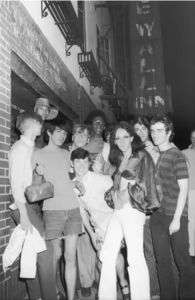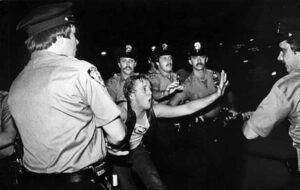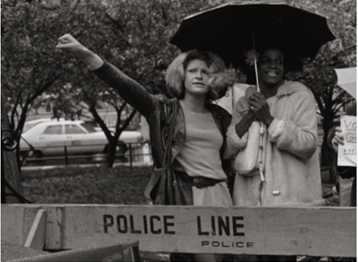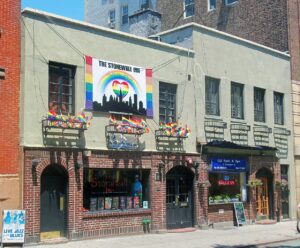In 1969, the tensions between the LGBTQ+1 community and the rest of society in the United States were on the rise. Queer 2 people of the time were tired of facing discrimination and needing to hide in the shadows. That need to hide came from the laws that were created to repress LGBTQ+ people. Those laws included anti-sodomy laws, anti-cross-dressing laws, laws that did not allow LGBTQ+ people to congregate, and more. Even though those laws existed, queer people still found ways to meet and hang out. Some of those ways were by dressing certain ways, using certain sayings, and having underground meeting places. These underground places were mainly bars located in major cities like New York, San Francisco, and Los Angeles. However, since it was illegal for LGBTQ+ people to congregate, these bars were frequently raided by the police. This is the story of the most important bar raid in LGBTQ+ rights history and of the women who used its power to change the course of history.3

It was the night of June 27, 1969, and queer people throughout New York City were getting ready to go out. Of the many places to go, the Stonewall Inn was a fan favorite. The Stonewall Inn was part of the Greenwich Village scene, which contained spaces where LGBTQ+ people would meet and party. Many of the bars in Greenwich Village were owned and operated by the mafias of New York City. This was how they had alcohol and were not raided as frequently as other bars. The Stonewall Inn was one of the few places queer people could go to get away and be around people who would not stare at them or belittle them—a place they could be free.4 Marsha P. Johnson and Sylvia Rivera were frequent customers of this establishment, and they were ready for a fun night. Deep down, everyone that headed to the Stonewall Inn knew there was a possibility it would be raided that night. However, the relief of being able to be yourself, even if only for a few hours, overrode that initial fear. If only they had known the plan the NYPD (New York City Police Department) had. As the sun went down, people from all over the city started to pack into the bar. Bright colors of the whole rainbow filled the bar. Trans men and women, drag queens, and people of all sexualities dressed in the clothes that they felt the most comfortable in, even if it was illegal for them to be wearing it. The music was so loud that everyone had to scream to be heard, and alcohol was being passed around to anyone who wanted some.5
Then suddenly in the early morning of June 28, someone started yelling about the police off in the distance. Everyone stopped for a second because they knew what that meant. The Stonewall Inn was about to be raided. Then the madness started, as there was a rush of people trying to get out of the bar before the police arrived. Everyone in the bars knew that if they got caught by the police, they would be arrested and charged with breaking one or more laws. Many times, when the police would raid bars, the press would also come and take pictures of people or publish the names of people who were arrested. This would mean their landlords or supervisors could find out that they were part of the LGBTQ+ community, putting them at risk of being evicted or fired. If that happened, it would also make it harder for them to get a new job or find a place to live. Police had been planning the raid on the Stonewall Inn for a while. They wanted to take down LGBTQ+ people and a part of the mafia’s income.6

Police arrived on the scene and people became more frantic. They started jumping out the windows, hiding in the bathroom, and running to get as far away as possible. Some police officers started pulling people who could not get out of the bar and beating them in the streets. Other police officers started arresting people. Police started sectioning off people into who would be arrested and who set free. Then something unheard of happened. Gay men and women started to argue back and swarm the police. Then trans women and drag queens started to do the same. Around this time, Marsha P. Johnson and Sylvia Rivera made it to the Stonewall Inn unaware of the raid taking place. They joined in arguing and fighting with the police. Suddenly, a brick flew through the air hitting a police officer in the head. All accounts said it was a woman who threw the brick and some also said it was a woman of color. There were some who said it was Marsha P. Johnson, but this has never been confirmed. This bar raid turned into a riot and continued throughout the night. This was only the beginning.7
The next day there was a sense of joy and energy in the air. This was LGBTQ+ peoples time to rise. This was because it meant no more hiding and the ability to start the push for equality and respect. Many people continued rioting with the police, including Marsha P. Johnson and Sylvia Rivera. However, they did even more than that. They knew from the civil right movement that the way to make change was to protest. They knew it was important to go out into the community and show people, peacefully, that what was happening to LGBTQ+ people was unjust. They gathered supplies, created signs, and called in their community. So, while others were rioting for six days, they were protesting.8

During these riots and protests there were many pictures taken. One of the most memorable is a photo of Marsha and Sylvia standing in front of a group of protesters by a police barricade, smiling. They are dressed in clothes that usually would have gotten them arrested, but police knew not to start a commotion for fear of more rioting. These women knew that the work they were doing fighting for LGBTQ+ rights would one day pay off and that these protests and riots were only the beginning of a much larger movement.9
The Stonewall uprising lasted from June 28 to July 3, 1969. This was considered the first Pride and is why June is considered LGBTQ+ pride month. Marsha P. Johnson and Sylvia Rivera are credited for continuing the fight for LGBTQ+ liberation. They took the anger, joy, and freedom queer people of this time felt and turned it into a larger movement. Unfortunately, bar raids, home raids, and discrimination continued for many years after Stonewall. However, Sylvia and Marsha never stopped fighting. 10
Both Marsha P. Johnson and Silvia Rivera were kicked out of their homes after coming out to their families as trans. Marsha was already living and working in New York City when Sylvia made her way there. After they met, they became close friends as they helped each other through the tough times of the world they lived in. Due to discrimination and other barriers, they were both forced into sex work to make money. Their lack of stable income meant they faced homelessness and lack of proper medical care. This was continuous throughout their lives and why much of their activism addressed these problems. They worked to bring a voice to queer people who lived in the shadows of their own community and started an organization for trans people who were homeless.11 They also spoke about the hardships of being an out trans person at the time and how many of them were forced to work exclusively as sex workers.12
Even with these incredible accomplishments, these women were left behind by their own community. As the gay liberation movement took off, trans people and queer people of color were left behind. Marsha P. Johnson and Sylvia Rivera spoke out about this in small and large ways. They called people in their community to help uplift those who they seemed to have forgotten. This helped and allowed gay, lesbian, and bisexual people of color to be included in gay liberation. Marsha and Sylvia again called on their community to help trans and other queer people who had been left behind. This helped but not fast enough. They both died before ever seeing liberation for trans women and everyone in their community. Marsha P. Johnson died in July of 1992 and Sylvia Rivera died in February of 2002. However, these women’s legacies continue on. Queer people use their legacies as inspiration to fight oppression and anti-LGBTQ+ legislation that would undo the work Marsha and Sylvia did. They are brought up in protests throughout the nation that stand up for trans youth and gender affirming care that is being threatened in the United States. Marsha and Sylvia’s use of their community and its resources has set a path for LGBTQ+ people to better fight for themselves and their community. Every year during Pride parades and celebrations they are honored and recognized as the heroes who allow LGBTQ+ people to live out and proud. In Greenwich Village there is a bust statue of Marsha P. Johnson in remembrance of her and Sylvia Rivera’s work and all they did for their community.13

Even though they were never able to see everything they accomplished come to fruition, their legacy will forever live on in the hearts and minds of all the people whose lives they forever changed. It is important that LGBTQ+ people continue to know the importance of these women and their work so they can continue the fight for true liberation but also see how far the United States has come. It is also important for non-LGBTQ+ people to know about these women to understand how hard it was to reach a point of tolerance for LGBTQ+ people and make sure the United States does not fall back into the oppression of queer people. There is still so much work to do, and these women show it is possible.14
- LGBTQ+ is a term used to express different sexual and gender identities, and stands for Lesbian, Gay, Bisexual, Trans, Queer, and all other people in this community ↵
- Queer is a another term for LGBTQ+. Queer was once a slur used to oppress and dehumanize LGBTQ+ people. It has since become a blanket term for LGBTQ+ people and some people even identify as Queer. ↵
- Marc Stein et al., The Stonewall Riots: A Documentary History (NYU Press, 2019), 1-27. ↵
- Salem Press Biographical Encyclopedia, August 2022, s.v. “Stonewall Rebellion Ignites Modern Lesbian and Gay Rights Movement,” by Barry Mann. ↵
- Marc Stein et al., The Stonewall Riots: A Documentary History (NYU Press, 2019), 28-30. ↵
- Marc Stein et al., The Stonewall Riots: A Documentary History (NYU Press, 2019), 31-48. ↵
- Marc Stein et al., The Stonewall Riots: A Documentary History (NYU Press, 2019), 49-56. ↵
- Marc Stein et al., The Stonewall Riots: A Documentary History (NYU Press, 2019), 57-59. ↵
- Marc Stein et al., The Stonewall Riots: A Documentary History (NYU Press, 2019), 61-62. ↵
- Marc Stein et al., The Stonewall Riots: A Documentary History (NYU Press, 2019), 63-65. ↵
- Salem Press Biographical Encyclopedia, March 2019, s.v. “Sylvia Rivera” by A. S. ↵
- Salem Press Biographical Encyclopedia, June 2022, s.v. “Marsha P. Johnson” by Matt W. Cody. ↵
- Marc Stein et al., The Stonewall Riots: A Documentary History (NYU Press, 2019), 229-270. ↵
- Marc Stein et al., The Stonewall Riots: A Documentary History (NYU Press, 2019),270-275. ↵

